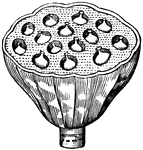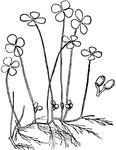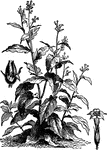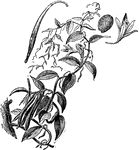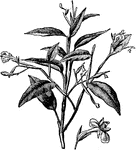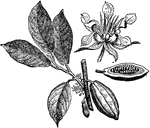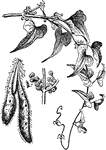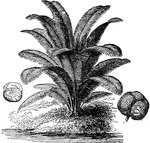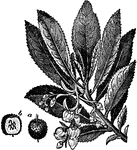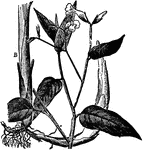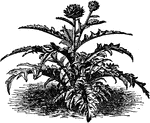
Ovary of Frost Weed
Cross section of the ovary of Frost-Weed (Helianthemum), with three parietal placenta, bearing ovules.
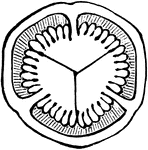
Hypericum graveolens
Cross-section of an ovary of Hypericum graveolens, the three large placenta meeting in the centre, so…

Ovule of a Magnolia
Three early stages in the growth of ovule of a Magnolia, showing the forming outer and inner coats,…

Silene Pennsylvanica
Longitudinal section of flower of Silene Pennsylvanica, showing stipe between calyx and corolla.
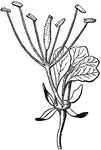
Flower of a Cleome
Flower of a Cleome of the section Gynandropsis, showing broadened receptacles to bear petals, lengthened…

Alga
Magnified view of some of a simple fresh water Alga, the Tetraspora lubrica, each sphere of which may…

Rhubarb-plant
Some cells from stalk of Rhubarb-plant, three containing chlorophyll; two (one torn across) with rhaphides.
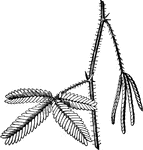
Sensitive Plant
Piece of stem of Sensitive Plant (Mimosa pudica), with two leaves. the lower open, the upper in the…

Telegraph-plant
Portion of stem and leaves of Telegraph-plant (Desmodium gyrans), almost of natural size.

Chondrus Crispus
Small plant of Chondrus crispus, Carrageen Moss; the spots represent the fructification, consisting…

Aphis Avence
Grain or oat-plant louse, does much injury to grain, and especially to oats, but is also found on wheat,…

Aphis Gossypii
Also known as the Cotton-plant louse, is a great nuisance to the planters, especially when the plants…
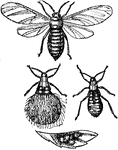
Wooly Aphid
Eriosoma Imbricata. Found very abundantly on birch in Maryland in October. These insects cluster together…

Moth Lantern
From the well known nocturnal habits of moths, and the certainty of their being destroyed by a light,…

Curvature of the Earth's Surface
If the earth were flat, as soon as an object appeared on the horizon we would see the upper and lower…
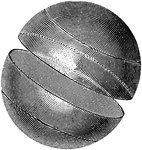
Great Circle
A Great Circle is one which would be formed on the earth's surface by a plane passing through the earth's…
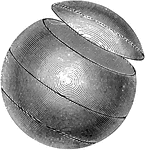
Small Circle
A small circle is one formed by a plane which does not cut the earth into two equal parts. The small…
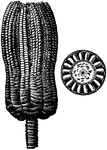
Fossil Encrinite
When the remains of an animal or plant are exposed to the air or buried in dry earth, they generally…
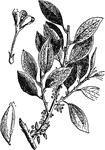
Coca
The coca plant is the source of the coca leaf used in medicine and in the production of cocaine
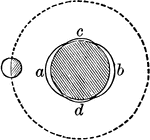
Lunar Tide
If the earth were uniformly covered with a layer of water, the passage of the moon over any place as…
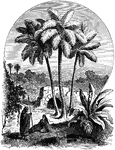
Palm Tree
Palms are one of the most well-known and extensively cultivated plant families. They have had an important…
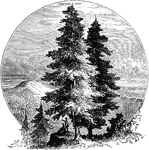
Pine Tree
Pines are native to most of the Northern Hemisphere. In North America, they range from Arctic south…

Sugar Cane
Sugar Cane is probably a native to India, but is now extensively cultivated throughout the tropical…

Tea Plant
Tea consists of the dried leaves of a number of evergreen shrubs, natives of China or thereabouts. Tea…

Coffee
Coffee is the berry of a tree found native in Abyssinia. The tree attains a height of 15 to 20 feet,…

Banner
The images in this banner are birds, flowers and vines. In the center there are to prominent birds and…
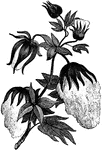
Cotton
Cotton is a soft fiber that grows around the seeds of the cotton plant. The fiber is often spun into…
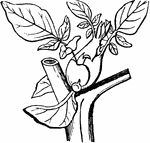
Tubers
Bulbet-like tubers, such as are occasionally formed on the stem of a Potato-plant above ground.
Five-ranked
Diagram of a shoot with its leaves 5-ranked, with a spiral line drawn from the attachment of one leaf…

Opposite-Leaved
Diagram of opposite-leaved plant with a cyne of three flowers; a the first flower, of the main…
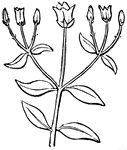
Opposite-Leaved
Diagram of opposite-leaved plant with a cyne of three flowers; a the first flower, of the main…

Sedum Ternatum
Parts of the same, two of each kind, separated and displayed; the torus or receptacle in the centre;…




